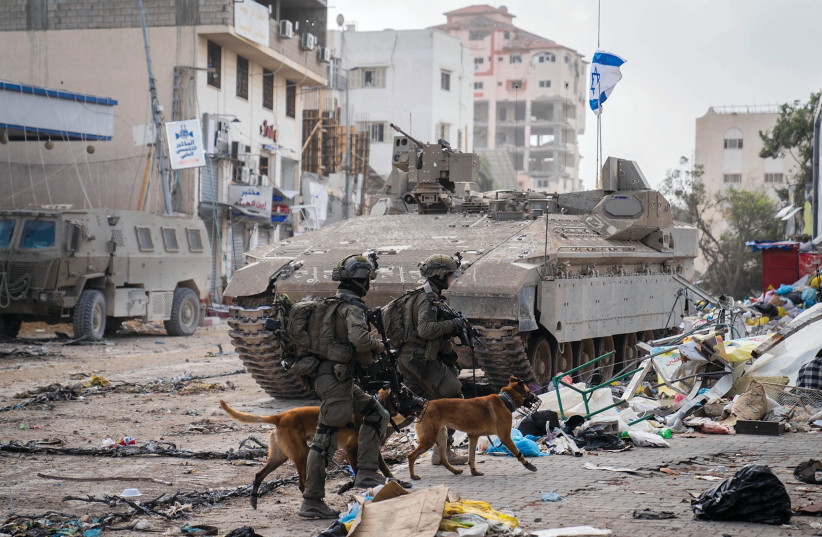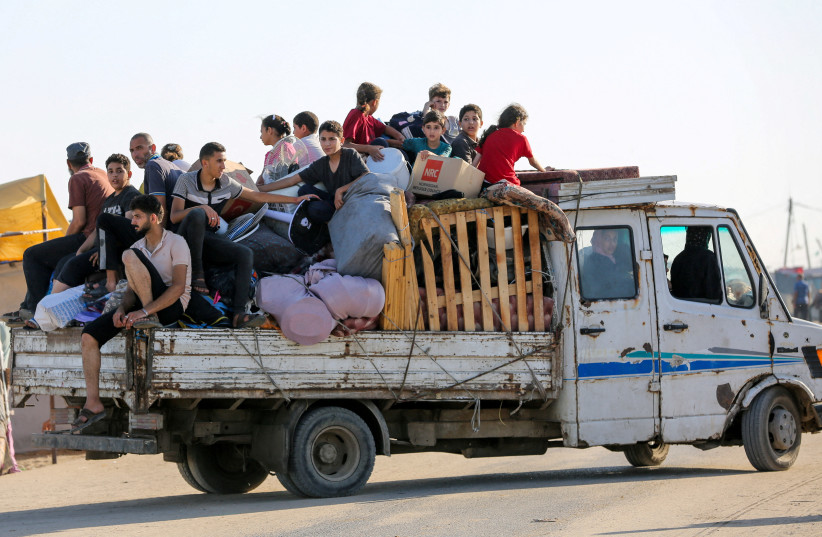IDF, Netanyahu fought over PA in Gaza – now its about withdrawal
From the start of the war, numerous top defense sources have told the Jerusalem Post that there was a subtle division between the defense establishment and Prime Minister Benjamin Netanyahu about the war’s goals.
That division has now become a massive gulf, the Post understands.
In public, everyone said that by attacking and destroying Hamas, the terror group would be more likely to give up hostages to obtain even temporary periods of quiet.
In that sense, the war’s two main goals, defeat Hamas and return the hostages, could be seen as complementary, and there was no conflict.
But this was always an artificial formula.

As the war wore on, it became clear that the IDF would not pull off some kind of Entebbe miracle rescuing all the hostages in one fell swoop (it has pulled off three amazing rescue operations, but the total rescued live hostages are still only seven), it also became clear that most live hostages would only be returned, if at all, through a deal or deals with Hamas (see the November 23-30 deal.)
Once that was true, it became apparent that the war’s two goals sometimes might be complimentary, but sometimes might contradict each other, top sources told the Post.
They were complimentary up until the point that Hamas was serious about cutting a deal. But once Hamas was serious about cutting a deal, any pause or other concessions that Israel would make to get the hostages back would in some way hamper or slow the war and could even end it.
Even as early as November, some top IDF officials started hinting to the Post that they would be ready to allow Hamas’s leader and their forces to escape Gaza and be expelled to a third country, like Qatar.
This was at the same time that in public, all officials were talking about the certainty that they would soon kill Gaza Chief Yahya Sinwar.
In December, many top Israeli officials even started to try to leak that he was already dead to try to intimidate Hamas forces to surrender en masse or to get some of his subordinates holding hostages to give them up to save their own skin.
This was despite the fact that Israeli intelligence sources at the time told the Post that all senior Israeli officials knew that Sinwar was alive and controlling hostage negotiations.
In any event, certainly, at the time, Netanyahu said that such a deal was out of the question and even tried to reduce public discussion of such an option.

By January-February, top defense officials were still ready for a deal with Hamas surviving and being expelled, but they had moved on to another controversial break with Netanyahu.
They were willing to cut another deal with Hamas even at the price of a much longer ceasefire than in November, and they wanted to immediately inject Palestinian Authority security forces into Gaza to replace the security vacuum left when the IDF routed Hamas from various areas.
Once again, Netanyahu vehemently rejected any consideration of involving the PA He rejected the idea not only because of his ideological opposition to giving the PA any positive role or momentum but also because he did not want to hint that the war was slowing down and injecting the PA into northern Gaza to manage a future peacetime period would signal the wrapping up of the war.
And yet all of this pales in comparison to the current gulf which sources have been saying behind-the-scenes to the Post and others in off-record briefings, but which the New York Times made much more public on Tuesday.
The majority of the IDF and the defense establishment have lost patience with Netanyahu being unwilling to get the remaining, or most remaining, hostages back by stopping the war, including an IDF withdrawal.
By May 20, the IDF had succeeded in taking over most of Rafah and believed it could wrap up that last major battle of Gaza within months or less.

There was a clear implication to completing the Rafah operation, which was ending the major operations of the war.
In truth, most of the war ended in February when the IDF finished off Hamas in both northern Gaza and Khan Yunis.
From early February until early May, with the exception of a brief re-invasion of Shifa Hospital in mid-March, there was almost no intense war going on.
There were mopping-up operations, and tunnels and rockets were being found and destroyed all over the place, but the number of IDF soldiers inside Gaza at one point fell from tens of thousands to around 1,000, with zero in Khan Yunis.
Netanyahu was not talking about this, but even without getting hostages back, defense officials viewed this as critical for the IDF, both to rest its majority reservist army, with many soldiers and their families experiencing meltdowns, and because, in any case, until Netanyahu and the US green-lighted a Rafah invasion, there just was no large Hamas force left to fight.
Not much left to do
In truth, Rafah has been mostly down for a week or more now.
IDF updates talk about killing a few Hamas fighters at a time per day, but there are no large battles.
When the Post was in Rafah a week ago, there was almost no gunfire or bombings as compared to when the Post visited Gaza City and Khan Yunis earlier in the war.
Hamas fled from the IDF in Rafah in record numbers, with only around 600 being killed out of between 3,000-8,000 fighters.
If the IDF has no one to fight, then why not stop the war, think most top defense officials.
Sinwar has made it clear that he will release all or most hostages if the IDF withdraws from Gaza.
Of course, there would need to be stages to make sure that the IDF does not carry out a full withdrawal without already getting many hostages.
But that is not what Netanyahu wants.
He wants a blurry line between merely declaring an end to major operations while keeping mop-up low-intensity conflict with Hamas open indefinitely.
On those terms, there has been no deal with Hamas for months, and this has angered top IDF officials.
Moreover, top IDF officials want to officially shift their attention and forces to the North to stare down Hezbollah or invade it if need be.
This is very hard to do when there is still significant conflict in Gaza.
Why is Netanyahu holding out to keep the war open when there is not really anyone to fight (there are 5,000-10,000 Hamas fighters who faded in with the civilian population, but there is no way of locating them en masse) and nine months have seemed to show the futility of finding Sinwar in the almost endless web of Gaza tunnels? (or finding him before all the hostages are dead)
Netanyahu supporters say it is a strategy and a focus on saving future Israeli victims from the nightmare of letting Hamas return, even if it means sacrificing some or many of the hostages.
Notice that Netanyahu has been talking more about bringing back hostages “dead or alive,” as opposed to just “bringing the hostages back.”
His critics say that he just wants to keep the war going to keep his government from falling, which, in turn, he is using to try to keep himself out of jail from his criminal trial problems.
Regardless of the why, the New York Times story has burst out into the open an open secret: the IDF is ready to withdraw and leave Hamas in power to get the hostages back. Netanyahu is not. Where this will go is anyone’s guess.





Comments are closed.